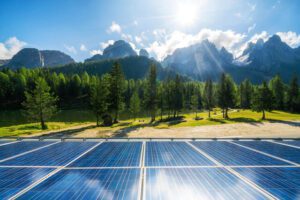After last week’s weather-themed post about how seasons change, I am prompted this week to highlight a number of sunny solar stories, led by the elevated profile of a solar-powered plane. So from grid parity to planes to parking lots, here are some signs of solar progress being made across the globe.
First up, let’s address the solar-powered plane. Two Swiss innovators are currently attempting to fly a solar-powered plane around the world, without any fuel whatsoever. Basically, the plane is decked out in 17,000 solar cells, which power the motors…which power the plane’s propellers.
The solar cells also charge a number of lithium batteries, which are then relied upon to power the plane at night. The plane weighs the same as a minivan, travels at around 28 miles an hour, but can double its speed when the sun’s rays are at their strongest.
The story of this rather unorthodox form of flight has prompted other articles this week to shine the light on unusual uses of solar power. While one article has drawn attention to solar panels on bike paths, tents, or car ports, another has pointed to its use on cars and keyboards.
The below map serves to show how solar is becoming a force to be reckoned with on a global scale. Solar costs have declined ~15% annually over the last 8 years, and are becoming increasing more competitive with retail electricity due to the reduction in solar panel costs, financing costs and balance of system costs. Their increasing use has also been attributable to tax credits, state renewable portfolio standards (RPS), and pro-solar policies.
That said, we are at a tipping point, as unsubsidized rooftop solar electricity costs between $0.08-$0.13/kWh, 30-40% below the retail price of electricity in many global markets. This research piece by Deutsche Bank projects another 40% reduction in solar costs over the next 4-5 years.
Such signs are leading to increasing optimism for solar generation in the US. According to Wood Mackenzie, solar could be cost competitive with traditional sources of energy across 19 US states within five years. This is expected to double to 38 states within a decade. But before we get too carried away, there is a need for tempered enthusiasm.
This year solar is expected to account for ~10% (2.2GW) of generation capacity additions in the US, with almost three quarters of this coming from California (1.2 GW) and North Carolina (0.4 GW). Wind generation accounts for nearly half of all new capacity additions (9.8 GW), while natural gas is set to add nearly three times as much new capacity (6.3 GW) as solar:
Despite the expectation that utility-scale solar capacity will increase by more than 60% by the end of 2016, it is still only expected to account for an average of 0.6% of total U.S. electricity generation (traditionally, solar growth has been concentrated in customer-sited distributed generation installations). Even in terms of renewable energy, solar only accounts for a small piece of the pie:
Despite finishing on a little bit of a bum note with these last two near-term snapshots of the US solar situation, this should not be a sign for discouragement; quite the opposite. A concerted effort on solar generation can yield startling results: we only have to look to Germany to see that (on a sunny weekend day it can meet up to 60% of electricity generation needs).
So while solar may not overtake natural gas-fired generation in the US for the next couple of decades, there is still the potential for it to be the leading source of global electricity generation by the middle of the century. A shiny happy prospect indeed.




Conversation
Solar industries are improving very fast, I hope it will continue to improve.
I aimed for a top of the line product and that’s what I got. The installers were friendly and efficient. I have already recommended your company to others. clean energy is one of best solar provider in Australia
I am doing a research on renewable energy specializing in solar and this article has helped me to gain an in depth understanding of different aspects of the solar energy and I am very grateful for having found such a resourceful page. Hope the writer will update articles on this site on a continually basis.